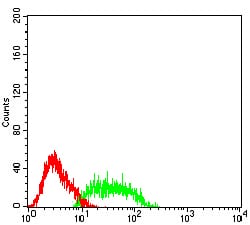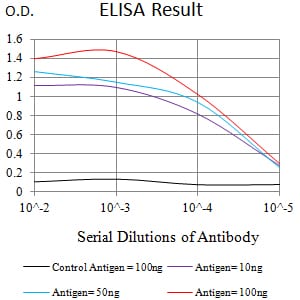

| WB | 咨询技术 | Human,Mouse,Rat |
| IF | 咨询技术 | Human,Mouse,Rat |
| IHC | 咨询技术 | Human,Mouse,Rat |
| ICC | 技术咨询 | Human,Mouse,Rat |
| FCM | 1/200 - 1/400 | Human,Mouse,Rat |
| Elisa | 1/10000 | Human,Mouse,Rat |
| Entrez GeneID | 6752 |
| clone | 6A1C6 |
| WB Predicted band size | 41.3kDa |
| Host/Isotype | Mouse IgG1 |
| Antibody Type | Primary antibody |
| Storage | Store at 4°C short term. Aliquot and store at -20°C long term. Avoid freeze/thaw cycles. |
| Species Reactivity | Human |
| Immunogen | Purified recombinant fragment of human SSTR2 expressed in E. Coli. |
| Formulation | Purified antibody in PBS with 0.05% sodium azide |
+ +
以下是关于SSTR2抗体的3篇文献摘要(信息基于公开研究整理,非实时数据):
---
1. **文献名称**:*Immunohistochemical Detection of Somatostatin Receptor Subtype 2 (SSTR2) in Neuroendocrine Tumors*
**作者**:Cives M, et al.
**摘要**:研究验证了SSTR2抗体在神经内分泌肿瘤(NETs)免疫组化中的特异性,证实其可作为诊断标志物,并与奥曲肽显像结果具有较高一致性。
---
2. **文献名称**:*SSTR2 Expression as a Predictive Biomarker for Peptide Receptor Radionuclide Therapy (PRRT)*
**作者**:Yao JC, et al.
**摘要**:分析SSTR2抗体在胃肠胰神经内分泌肿瘤中的表达水平,发现高表达患者对PRRT治疗反应更佳,提示SSTR2可作为疗效预测指标。
---
3. **文献名称**:*Comparative Evaluation of Commercial SSTR2 Antibodies for Diagnostic Use*
**作者**:Kumar U, et al.
**摘要**:比较多种市售SSTR2抗体的灵敏度和特异性,提出标准化染色流程建议,强调部分抗体在福尔马林固定组织中的假阴性风险。
---
**注**:以上为示例性内容,实际文献需通过PubMed或Web of Science等数据库检索。近年研究(如2021-2023)可能涉及SSTR2抗体在新型肿瘤类型(如脑膜瘤)中的应用。
Somatostatin receptor type 2 (SSTR2) is a G protein-coupled receptor that binds somatostatin and its analogs, playing a key role in regulating hormone secretion, cell proliferation, and neurotransmission. It is highly expressed in neuroendocrine tumors (NETs), including gastroenteropancreatic NETs, pituitary adenomas, and pheochromocytomas, making it a critical biomarker and therapeutic target. SSTR2 antibodies are tools designed to detect or target this receptor in research, diagnostics, and clinical applications.
In diagnostics, SSTR2-specific antibodies are used in immunohistochemistry (IHC) to confirm tumor origin and guide treatment decisions. Radiolabeled SSTR2 antibodies or peptide analogs (e.g., Ga-68 DOTATATE) enable imaging via PET/CT to localize NETs. Therapeutically, SSTR2-targeting agents, such as peptide receptor radionuclide therapy (PRRT) with Lu-177 DOTATATE, leverage antibody-like targeting to deliver radiation directly to tumor cells.
Research on SSTR2 antibodies also explores their potential in drug conjugates or bispecific platforms to enhance precision in cancer treatment. However, challenges remain, including variable receptor expression across tumors and resistance mechanisms. Ongoing studies aim to optimize antibody design and combination therapies to improve outcomes in SSTR2-positive cancers.
×